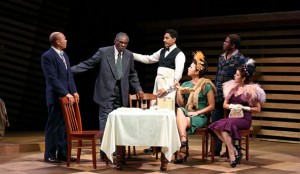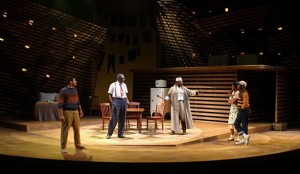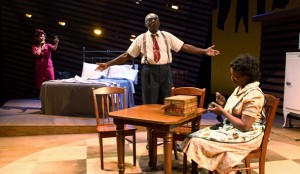NOT MUCH LIFE IN DEATH
The miracle of Arthur Miller’s Death of a Salesman is that it contains so many themes relevant to today’s world’”the American Dream, the disconnect of father and son, a lifetime of work resulting in fiscal emptiness, self-deception’”that this 1949 play can truly be called timeless. Yet so lifeless and lacking in subtext is Marc Masterson’s production at South Coast Rep that, had I never seen the play before, it would be tough to convince me of its status as one of the greatest plays ever written.
Great plays are only powerful when characters are portrayed by actors who are keen to bare their emotional scars, making theater come alive. Instead of directing his cast to plumb the depths, Masterson allows them to deliver lines with a sort of false earnestness, leaving us to wonder why this revival was produced at all. Slow and steady is one thing, but this play needs to growl. This seminal script is like a beautiful and well-built Packard, but it needs desperation, fear, anger, passion and heat to fuel it. Apparently, Masterson thought that placing a nearly all-black cast on stage would somehow make Miller’s tragedy of the common man sparkle in new ways. It does not. Skin color doesn’t matter if the content of character lacks vitality. Still, while the casting ploy offers nothing revelational, neither is it detrimental.
This is a memory play in which salesman Willy Loman’”60, suicidal, despondent, lonely, mercurial, desperate, and barely clinging to sanity’”suddenly aborts a business trip and returns to his wife, Linda, and their New York City home. Also living at home are Willy’s floundering adult children: Biff, a once-promising football star, and Happy, a womanizing and lost sales assistant. Throughout the play, scenes from Willy’s past are played out as he examines his legacy.
Miller calls for a non-representational set which allows for actors to heed imaginary wall lines in one scene and step through a wall for scenes from the past. We can see actors through the slits of Michael B. Raiford’s oddly angled set of slatted wood, but the huge (and admittedly beautiful) scenery never alters; as such, it’s as if Eames designed a giant piece of furniture never meant to be used. And would someone explain those curious puffs of smoke coming from the fly space up stage? Equally confusing are the refrigerator and telephone, the only items representational of the 1940s, and the Lomans’ bed, which sits practically center stage the entire play. Although this bed will also be used for a crucial scene in a hotel from Willy’s past, it just sits there like the rest of the play.
photos by Debora Robinson/SCR
Death of a Salesman
South Coast Repertory in Costa Mesa
scheduled to end on September 29, 2013
for tickets, call (714) 708-5555 or http://www.scr.org





